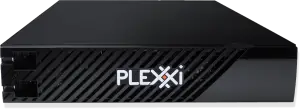Composable Cloud is the next step in HPE’s vision of the future in hybrid IT – enabling on-premises IT to operate like cloud and manage cloud consumption across multiple clouds. The major news during the conference is Composable Fabric – the new branding of Plexxi within the HPE portfolio. Composable Fabric was the missing piece that allows HPE to compose rack-mount servers, in addition to the HPE Synergy platform.
While HPE has been talking about Composable Fabric for a while on the Synergy platform, it didn’t have a product that allowed its rack servers to have composed networking. HPE OneView has been a great addition to the automation portfolio for HPE, but the lack of networking support is glaring in the lineup, until now. Synergy has a narrowly defined number of ways that it can be installed and connected, so networking in Synergy is somewhat easier for the company to handle. So, for now, HPE has two Composable Fabric solutions – one in its Synergy chassis and one based on Plexxi for rackmount.
Composable Fabric/Plexxi is a very cool solution. It is intended to be used all the ways that a rack-mount installation may be created. With Plexxi switches, you take the switches out of the box and cable them together in any way you desire and they form a base broadcast network that knows all the elements and can load balance traffic across the fabric. Add cabling to your Plexxi enabled DL380’s and you can begin to build a fully automated pool of systems.
 Plexxi OS, the switch software, runs on HPE/Plexxi certified switches, which are open standard switches (aka whitebox switches). The Plexxi folks I spoke with said the code would likely run on other open switch platform, however, it would not be certified and supported. Like all other open networking solutions, the secret is in the software. A controller is used to define the configuration of the network and then handle all of the ways that interconnection can occur.
Plexxi OS, the switch software, runs on HPE/Plexxi certified switches, which are open standard switches (aka whitebox switches). The Plexxi folks I spoke with said the code would likely run on other open switch platform, however, it would not be certified and supported. Like all other open networking solutions, the secret is in the software. A controller is used to define the configuration of the network and then handle all of the ways that interconnection can occur.
In some ways, it seems that Cisco’s network-centric design that encompassed both blades and rack mount servers was the right approach and the Plexxi acquisition is a step to correct this. Albiet, the two approaches are different – one with open hardware (HPE Composable Fabric) and specific software versus the Cisco method of tightly coupled hardware and software. Also glaring at this point is that Cisco has a single management plane and HPE’s solution has two – the Plexxi management and HPE OneView.
Unfortunately, Plexxi is HPE’s solution for rack-mount servers only currently, though I expect to see something similar introduced on Synergy – it is just logical (but I have no inside information). I also wonder how long the Plexxi controller will exist separate from OneView – again I think it is a logical step to merge those two functions together. While the composable cloud includes the newly rebranded Plexxi code and release, HPE also introduced a Simplivity/Plexxi package also during the conference based on the latest 4.x release.
For more information, check out the news release from HPE.
